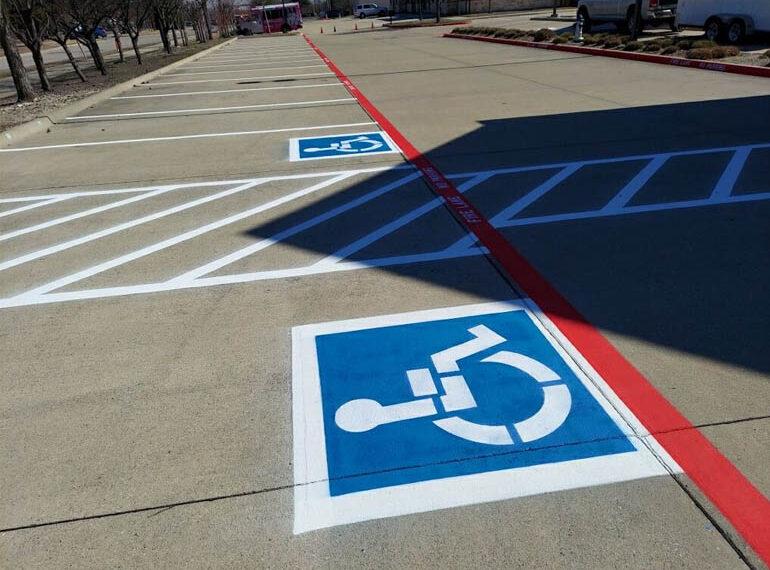
Picture a world where even routine tasks like grocery shopping or dining out become complicated for people with mobility difficulties. This is the reality that accessible parking spaces seek to transform. Parking spaces are not just ordinary patches of pavement – they are safe pathways for people with disabilities. These parking spots enable them to participate in everyday activities that many may not even think twice about.
The Americans with Disabilities Act (ADA) is a crucial law that aims to make spaces accessible and meaningful for all. It was enacted in 1990 and is a beacon of equality, championing the rights of the differently-abled by dismantling barriers that hinder their full participation in society.
These requirements, which are unfortunately often overlooked, are the blueprint for ensuring that accessible parking spaces are not just a symbolic gesture but a tangible commitment to inclusivity. Below, we explore the standards for accessible parking spaces by delving into ADA’s parking lot striping standards and the common mistakes to avoid to guarantee compliance.
Minimum Standards for Accessible Parking Spaces
The first step in ADA compliance is calculating the minimum number of accessible parking spaces your lot should have.
- 1 to 25 total spaces: At least one accessible space
- 26 to 50 total spaces: At least two accessible spaces
- 51 to 75 total spaces: At least three accessible spaces
- 76 to 100 total spaces: At least four accessible spaces
- 101 to 150 total spaces: At least five accessible spaces
- 151 to 200 total spaces: At least six accessible spaces
- 201 to 300 total spaces: At least seven accessible spaces
- 301 to 400 total spaces: At least eight accessible spaces
- 401 to 500 total spaces: At least nine accessible spaces
- 501 to 1000 total spaces: At least 2% of total spaces
Parking Lot Striping Standards
Striping refers to the lines, markings and symbols painted on parking lots. It is crucial for optimizing space usage, enhancing safety and creating a well-structured environment within a facility.
The following are the requirements for ADA compliant parking lot striping:
Clear and Visible Lines
A well-organized parking lot requires clear and highly visible striping with crisp lines and distinct contrasts between paint colors. This makes it easy for drivers to identify parking spaces, pathways and pedestrian crossings. Adequate distinction is particularly important for visually impaired individuals who rely on vibrant visual cues to navigate. Property owners can ensure everyone can move around the parking lot effortlessly by fulfilling ADA parking striping requirements.
Width and Spacing of Parking Spaces
When it comes to accommodating a variety of vehicles and mobility aids, it’s essential to maintain consistency in the width and spacing of parking spaces. According to the ADA parking striping requirements, standard parking spaces should be at least 8 feet wide. It’s also essential to ensure a uniform distance between each parking space, usually around 5 feet, to provide sufficient room for drivers to park and maneuver their vehicles.
Access Aisles and Pathways
According to ADA’s parking lot striping standards, access aisles should have a minimum width of 5 feet to provide individuals using mobility devices the space they need to transfer in and out of their vehicles comfortably. These pathways must remain unobstructed and marked to enable safe passage for all pedestrians.
Common Mistakes to Avoid To Ensure ADA Compliance
Creating an accessible and inclusive parking lot is of utmost importance. However, it is often easy to neglect specific details that could result in unintentional non-compliance with ADA parking striping regulations. To ensure that your facility genuinely caters to the requirements of all individuals, it is necessary to avoid these typical errors.
Below, we discuss some of these pitfalls and how to prevent them.
- Poor Sign Placement: Placing accessible parking signs too low, too high or in obscure locations can confuse drivers and pedestrians. Ensure signage is visible and appropriately positioned to guide users effectively.
- Faded or Worn Striping: As time passes, weather and wear can cause the striping in parking lots to fade. This can make it hard for people to identify designated spaces and walkways. To maintain accessibility, it’s essential to re-stripe the parking lot regularly.
- Non-Compliant Ramp Construction: If ramps are a part of your parking lot design, ensure they meet ADA standards for slope, width, handrails, and surface texture. Inadequate ramp construction can hinder access and pose safety risks.
- Lack of Regular Audits: Failing to conduct regular accessibility audits and assessments can lead to unnoticed violations. Regular reviews with experts can help identify and rectify issues promptly.
- Disregarding Landscaping and Obstructions: Obstructions such as landscaping elements or parked vehicles that take up accessible parking spaces or pathways can cause difficulties for users. To ensure full accessibility, it is crucial to maintain clear paths and areas.
Paving the Path to Inclusivity With ADA Compliant Parking Lot Striping
Creating an accessible and welcoming environment requires attention to detail. Even seemingly minor details, like parking lot striping, can profoundly impact individuals with disabilities. These lines and symbols are not just for aesthetics but are essential for ensuring inclusivity.
If you want to transform your parking lot into an accessible space, it is essential to seek out professionals who specialize in parking lot striping and maintenance. They understand the intricate requirements of the Americans with Disabilities Act, ensuring that every detail is carefully considered.
Contact us today to discuss how our team of experts can help you.





